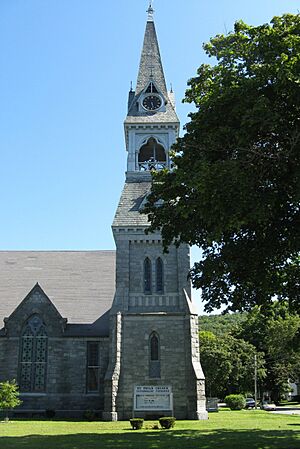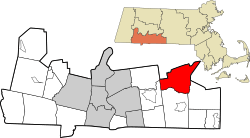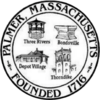Palmer, Massachusetts facts for kids
Quick facts for kids
Palmer, Massachusetts
|
|||
|---|---|---|---|

St. Paul's Church
|
|||
|
|||
| Nickname(s):
"Town of Seven Railroads"
|
|||

Location in Hampden County in Massachusetts
|
|||
| Country | United States | ||
| State | Massachusetts | ||
| County | Hampden | ||
| Settled | 1727 | ||
| Incorporated | August 23, 1775 | ||
| Government | |||
| • Type | Council-manager | ||
| Area | |||
| • Total | 32.00 sq mi (82.88 km2) | ||
| • Land | 31.58 sq mi (81.78 km2) | ||
| • Water | 0.42 sq mi (1.09 km2) | ||
| Elevation | 330 ft (101 m) | ||
| Population
(2020)
|
|||
| • Total | 12,448 | ||
| • Density | 394.22/sq mi (152.21/km2) | ||
| Time zone | UTC-5 (Eastern) | ||
| • Summer (DST) | UTC-4 (Eastern) | ||
| ZIP code |
01069
|
||
| Area code(s) | 413 | ||
| FIPS code | 25-52144 | ||
| GNIS feature ID | 0619387 | ||
Palmer is a town in Hampden County, Massachusetts, United States. About 12,448 people lived there in 2020. Palmer is part of the larger Springfield area. It has a special way of governing itself, with a council-manager system.
Palmer is made up of four smaller areas, or villages. These are Bondsville, Thorndike, Depot Village, and Three Rivers.
Contents
History of Palmer
Palmer is known for its four unique villages. These are Depot Village, Thorndike, Three Rivers, and Bondsville. Depot Village is often just called "Palmer." It's famous for its beautiful Union Station train terminal. A well-known architect named Henry Hobson Richardson designed it.
The villages started to grow in the 1700s. By the 1800s, train lines and trolley lines helped more people move to the town. Today, each village has its own post office. All but Thorndike also have their own fire station.
Early Settlers and Names
Palmer was once part of Brimfield. But it was too far away, so it became its own town. The first settler was John King, who built his home in 1716. This area was first called "The Elbow Tract."
In 1731, the town was renamed 'New Marlborough.' This was after Marlborough, Massachusetts. Later that year, it was called 'Kingsfield' after John King. A large group of Scots-Irish people arrived in 1727. Finally, in 1752, the town was named Palmer. This was in honor of Chief Justice Palmer. In 1775, Massachusetts officially made Palmer an incorporated town.
Growth of Industry
Depot Village became the main business area of Palmer in the late 1800s. It is still the center today. Palmer's factories grew in Bondsville. In the 1700s, mills for cutting wood and grinding grain were built. By 1825, Palmer started making textiles, which are fabrics.
Big factories like Blanchard Scythe Factory and Wright Wire Woolen Mills grew. They even built homes for their workers. By 1900, Boston Duck, which made heavy cotton fabric, had over 500 employees. In the 1900s, more immigrants from Poland and French Canada moved to Palmer.
Geography of Palmer
Palmer covers about 32 square miles (82.9 square kilometers). Most of this area is land, with a small part being water. The town is surrounded by several other towns. These include Ludlow, Wilbraham, Belchertown, Ware, Warren, Brimfield, and Monson.
Population and People
In 2000, there were about 12,497 people living in Palmer. The town had about 5,078 households. Many families lived there, with 31.6% of households having children under 18. About 48.5% of households were married couples.
The population included people of different backgrounds. Most residents were White (96.82%). There were also smaller groups of Black, Native American, and Asian people. About 1.23% of the population was Hispanic or Latino.
The average age in Palmer was 38 years old. About 25.2% of the people were under 18.
Economy and Development
Future Growth
A new race track called Palmer Motorsports Park opened in Palmer in May 2015. It was built by the New England Region of the Sports Car Club of America. This track is 2.3 miles long and has many changes in elevation. Road & Track magazine even called it one of the top 10 racetracks in North America!
Supporting Businesses
The Quaboag Hills Chamber of Commerce is located in Palmer. This group helps businesses and the community grow in the Quaboag Valley area. It gives over 200 members a voice in important local issues.
Education in Palmer
Palmer has three schools for its students. Old Mill Pond Elementary School teaches students from kindergarten to 5th grade. Palmer High School serves students from 6th to 12th grade.
Pathfinder Regional Vocational Technical High School is also in Palmer. It offers special training for grades 9 through 12. Camp Ramah in New England, a summer camp, is also located in Palmer.
Infrastructure and Transportation
Railroads in Palmer
Palmer is known as the "Town of Seven Railroads." This is because it once had many train lines. Five of these were active: Boston & Albany, Central Vermont, Springfield, Athol & North-eastern, Ware River, and Central Massachusetts. One line was built but never used, and another was not finished.
These railroads used Union Station. Today, some of these lines are still used by different companies. For example, the New England Central Railroad uses part of the old Central Vermont line. The Massachusetts Central Railroad uses parts of the Ware River and Central Massachusetts lines.
Amtrak trains, like the Lake Shore Limited, still pass through Palmer. However, no trains have stopped at Palmer since 1971. Union Station is now privately owned and has a restaurant. There are plans to build a new train station in Palmer as part of the West-East Rail project.
Roads in Palmer
I-90, also known as the Massachusetts Turnpike, has an exit in Palmer. This exit leads to Massachusetts Route 32. Route 32 runs through the center and eastern parts of the town. U.S. Route 20 also goes through Palmer. It crosses Route 32 and MA 181 in the town center. Route 181 goes north into Three Rivers and Bondsville. MA 67 runs along the eastern side of Palmer.
Fire and Water Services
Unlike many towns, Palmer does not have one main water department. Instead, Palmer, Bondsville, and Three Rivers each have their own water and fire departments. Each fire department has its own chief. Thorndike does not have its own fire or water department. It gets these services from Palmer. The Thorndike Fire Department closed after World War II.
Notable People from Palmer
- Henry King, a U.S. Congressman
- Marie-Claire Kirkland, a Canadian lawyer and judge
- Taj Mahal, a famous musician
- Suzanne Strempek Shea, an author
- Chad Stahelski, a film director
- Chuck Thompson, a sportscaster for the Baltimore Orioles and Colts
- Bob Wilder, a racing driver
- Irving Calkins, a sport shooter
See also
 In Spanish: Palmer (Massachusetts) para niños
In Spanish: Palmer (Massachusetts) para niños




